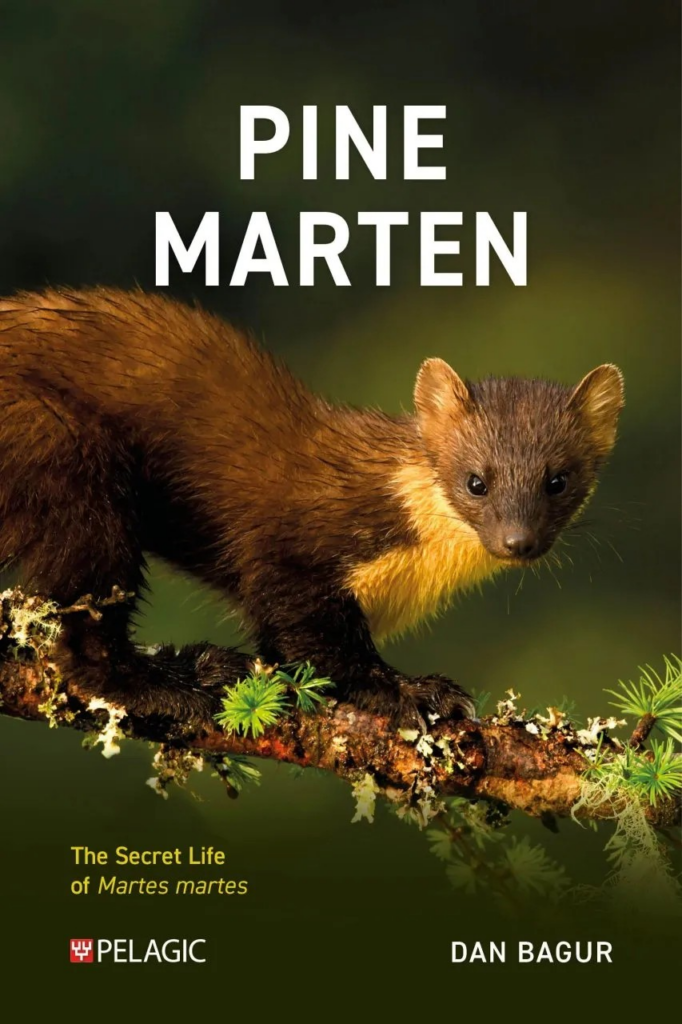 Offering new insights into how they grow, learn and live, Pine Marten delves deep into the secretive behaviour of one of our rarest and most elusive mammals. Packed with stunning candid images and a library of behaviours and vocalisations, this groundbreaking book provides insight into Pine Marten social interactions, courtship, mating, nesting and kit rearing, feeding and diet, as well as their relationships with other wildlife.
Offering new insights into how they grow, learn and live, Pine Marten delves deep into the secretive behaviour of one of our rarest and most elusive mammals. Packed with stunning candid images and a library of behaviours and vocalisations, this groundbreaking book provides insight into Pine Marten social interactions, courtship, mating, nesting and kit rearing, feeding and diet, as well as their relationships with other wildlife.
Having spent several years watching and filming Pine Martens in the forests of Austria, Bavaria and Ireland, Dan Bagur has developed an in-depth understanding of their habits and behaviour. He has written or contributed to over 26 books on nature, and his wildlife photography, artwork and articles are published all over the world.
We had the opportunity to speak to Dan about Pine Marten, including his inspiration for the book, his hopes for the future of Pine Martens in the UK and more.
Can you start by sharing how you first came to work with Pine Martens, and what was the journey that led to the publication of this book?
Before answering, I was pleased when my publisher told me that you wanted to interview me. I’m a lifelong admirer of the NHBS. I used to get your catalogues delivered as a teenager back in the early 90s when you were still a mail-order book catalogue – I’ve bought and enjoyed many books from you over the years.
Back to your question. Yes. As a nature lover, I’ve always wanted a house surrounded by wildlife. When I moved to Ireland, it finally became a reality. The first time I viewed the house, I found a Pine Marten scat in the garden! It’s a dream for someone like me to be surrounded by these endangered mammals and I’ve been watching their behaviour ever since. Being so elusive, they represent a significant challenge to the wildlife photographer/filmmaker, it occurred to me that Pine Martens would be one of the toughest land mammals to study in the wild – observing them is so rewarding precisely because it’s so difficult. You must earn every new insight.
Direct observation is the best way to learn; the animals themselves are the primary source after all. It starts with interest but quickly becomes, well, the word that comes to mind whenever I think about exactly how to define it is joy. Joy can be very addictive. It’s hard to let go of that feeling. Being plugged directly into the Pine Martens and their daily lives is exciting.
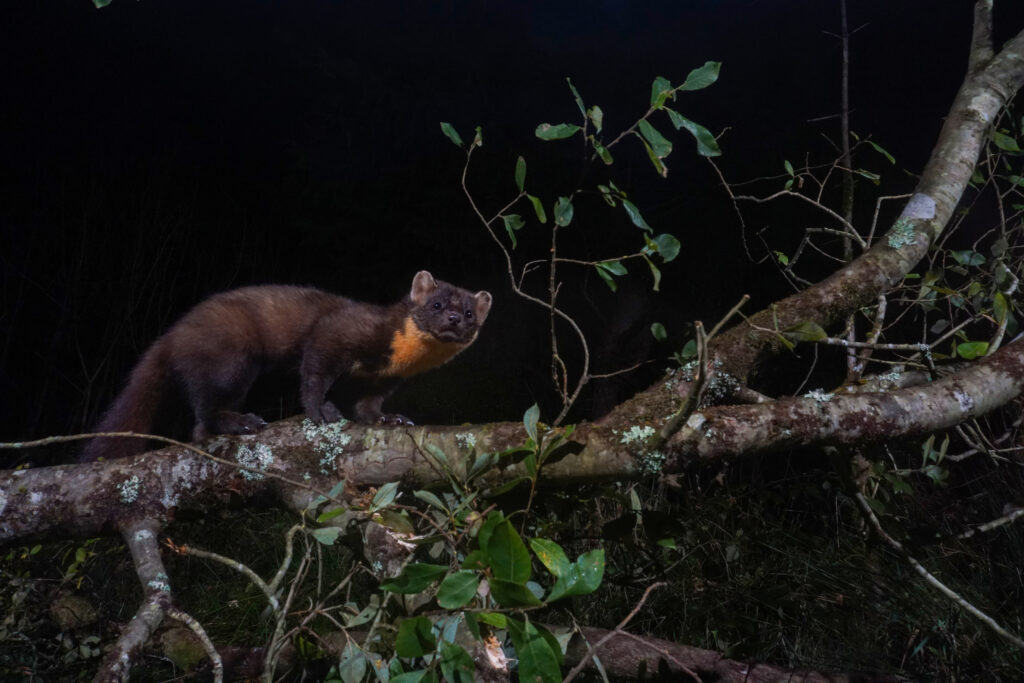
A long field study enables you to get a much clearer picture of what’s really happening: you get to confirm and reconfirm your initial assumptions, connect to individuals and see their interactions and behaviour over an extended timescale. I’ve been observing wild Pine Martens for over five years now – I’ve spent many thousands of hours following, watching and photographing them. I’ve encountered many individuals and seen them climbing, courting, growling, chattering, hunting, feeding, fleeing, fighting and rearing their young. Every month I learned something new and understood them a little better. It’s a great help too that Pine Martens fit nicely around a full-time job – most of the action takes place at dawn and dusk, or during the night. I got drawn into their world. I often wonder what they’re doing while I’m not with them.
As Pine Marten populations slowly begin recovering, interest in them is growing and I thought that my observations could be of interest to other naturalists. Conservation relies heavily on public sentiment and if people don’t know about Pine Martens, they will be less likely to help them. Introducing this animal to others was something I felt I could do. Hopefully, after reading this book, the reader might offer Pine Martens their much needed support. I put the focus of the book on Pine Marten behaviour. It’s aimed at amateur naturalists or anyone who is interested in learning more about these incredible animals, and contains lots of new information and photographs that will be interesting to those who already know Pine Martens well.
What was the most surprising or exciting thing you learned in the process of writing Pine Marten?
I think it’s exciting that you can still go out into the woods and make new discoveries about British mammals. Although I studied biology at university, and have always worked in conservation related roles, I don’t work with Pine Martens professionally. That’s part of the magic of direct observation – anyone can do it. There are still many new discoveries out there just waiting to be made, all that’s required is consistency and patience.
I think the most surprising things are how vocal Pine Martens can be and how exciting each sighting still is – even after many years watching them. When they show up it’s always an ‘oh wow!’ moment. I still freeze with awe when I see one.
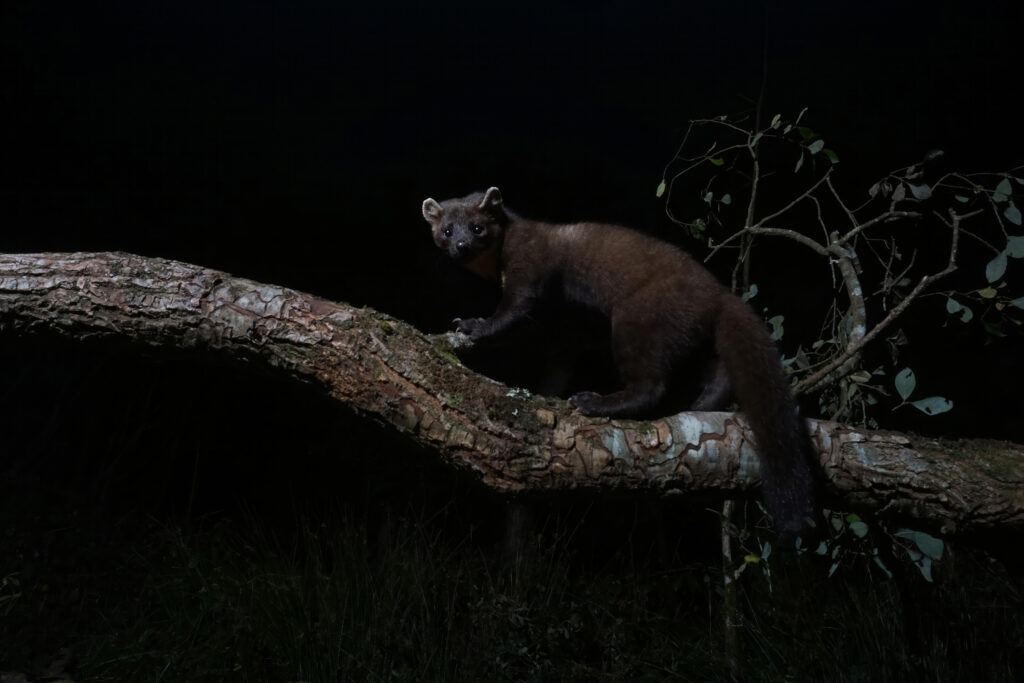
The most fascinating thing is their intelligence. Watching them solve problems and consider their next move, getting to know many individuals and seeing how unique each animal is – their personality and behaviour are highly individual. Often, I could tell who had visited simply by the signs they had left behind. They’re exceptionally charismatic animals. As I explain in the book, they’re also deeply connected with our historic wilderness landscapes, icons from our lost ancient wildwood.
This book has an impressive selection of imagery displaying a range of behaviours, interactions and life stages. How long did these images take to compile and what are some of your most effective strategies for spotting these elusive creatures?
Thanks. Yes, capturing Pine Marten behaviour isn’t easy. For every photo there were many failed attempts, you have to be comfortable in failure with Pine Martens. Over time, patience brings results and consistency is the key. The situation is made especially testing as it’s often at night and it can be very cold. You have to be willing to spend many thousands of hours sitting quietly in the woods and waiting for the occasional glimpse! For this reason, you have to really want to do it. You need to be passionate about understanding them.
I’ve taken over 10,000 photographs of Pine Martens over the last five years. Each year I understood a bit more about when and where I might see some new behaviour. Because they’re so elusive, learning to track them is essential. It’s vital that you wait as close to the right place as possible. It’s a waiting game – many quiet hours watching the forest, followed by a few seconds of heart racing panic as they emerge from the undergrowth and then quickly disappear again. Over time, it’s possible to build up a behavioural picture from many of these fleeting encounters. The harder something is, the greater that feeling of accomplishment.
Aside from sitting and watching, I also use trail cameras and camera traps to enable me to capture as much behaviour as possible. As you say, I’ve included over 200 photographs in the book because I felt that it was important to show the reader the behaviour that was being described. No number of words beats seeing behaviour in a photograph (or series of photographs as is often the case in this book). 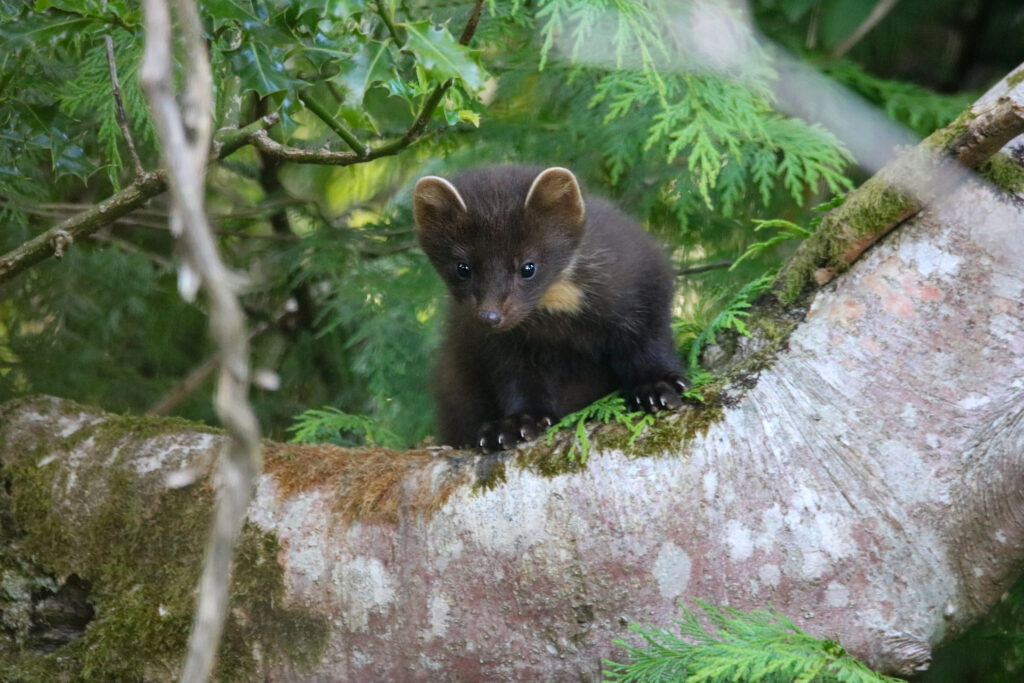 Young Pine Marten. ©Dan Bagur 2025
Young Pine Marten. ©Dan Bagur 2025
Can you tell us more about your new discoveries in Pine Marten behaviour and biology?
I didn’t set out to discover anything new. Initially, I didn’t plan to write a book. I just wanted to watch them and understand as much as possible – I was curious about how they lived their lives and what they got up to. As previously mentioned, I’ve spent over five years sitting quietly and observing wild Pine Marten behaviour. It took many months before I even knew where to wait for them. I love being alone in nature, so even the downtime in the forest has its own magic. My efforts were rewarded much later when I realised that some of my findings were new discoveries, including a new understanding of the function of the famous Pine Marten wiggle, retromingency in Pine Martens, the true cause of the scat curl and the use of the marten maze. I don’t want to give too much away, but they are all described (along with many other aspects of Pine Marten behaviour) in this new book.
Chapter 5 has an extensive library of field recordings. Why did you feel this was important to include and can you tell us about the process of gathering these?
It’s important to record what you’re seeing while watching wild animals, if you don’t then you can’t share your findings with others. Over the last few years, I’ve built up a large collection of film footage, photographs and sound recordings. Few people have ever seen a wild Pine Marten, let alone heard one. Their calls are an important part of what makes them what they are. Pine Martens (like many other Mustelids) make a surprisingly diverse range of calls – they grunt, growl, purr and scream. I felt it was important to include these. They are quickly and easily accessed by scanning QR codes using your phone. I wanted the reader to get as close as possible to Pine Martens via this book.
I realised that the recordings I had built up were unique – the Pine Marten sound library in this book is the most comprehensive yet published. My recordings have been included in the British Library sound collection and have been published in the ground-breaking book Sound Identification of Terrestrial Mammals of Britain & Ireland by Pearce, Middleton, and Newson.
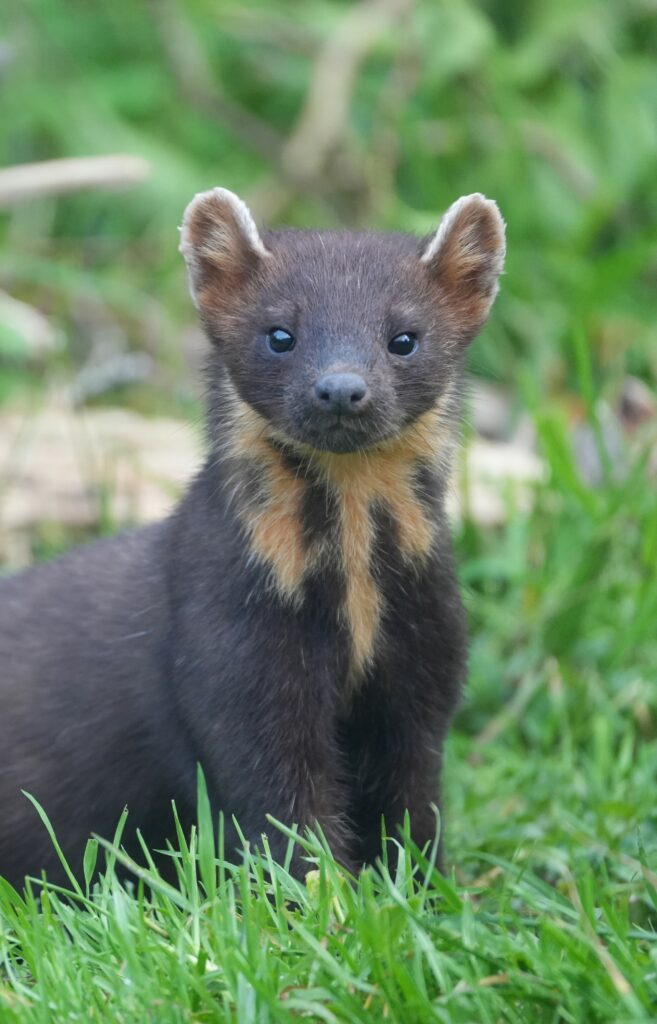
What does the future look like for Pine Martens in the UK? And how can we work to secure a brighter future for this species?
In short, hopeful but worrying! Sadly, much of this is our own doing. Urban sprawl and habitat loss are an obvious problem, climate change, biodiversity decline and a persecution driven genetic bottleneck add to these issues – among others. Apathy is also a big concern. We still prefer the comfort of fool’s paradise over the often-harsh difficulties of reality. We need to get our heads out of the sand – and fast! Reality will inevitably have consequences we are no longer able to hide from – not just for Pine Martens. As Tew et al stated in a 2024 paper on the future of UK woodland biodiversity, a ‘major cultural shift’ is urgently required.
Although it’s important to face our problems and act, it’s also important to remain positive. There is real cause for hope – important work is being done to help Pine Martens. A few of those making a huge difference are Johnny Birks, Jenny MacPherson, Stuart Edmunds and John Martin, but there are many others. When great people come together fantastic things can be accomplished. The UK and Ireland have plans to increase their much-depleted forest cover over the coming years, and Pine Martens are slowly coming back. There are ways we can all contribute by donating or volunteering. Even small acts, like rewilding our own gardens, can collectively have an impact. Writing in 1992, the acclaimed science writer Edward O Wilson stated that ‘The next century will, I believe, be the era of restoration in ecology’. I hope that he’s right – wouldn’t that be a fantastic thing to witness after the global habitat and biodiversity decline of recent years.
Finally, what’s next for you? Will there be more books in your future?
Yes, I hope so! I had a column on rock pool life in the local newspaper while I was at university and I’ve been writing in one form or another ever since. I’m always working on the next project. Writing forces you to read everything and really understand your subject deeply, and that brings its own reward.
I would like to do something with Puffins in the future. I’m inspired to continue spending time out in nature and see what else is waiting to be discovered. Whatever comes next, I will always be grateful for this time with the Pine Martens – so many wonderful memories and experiences. The Pine Martens will remain with me for the rest of my life. Once you get to know a family of Pine Martens there’s no going back. They’re incredible animals and we’re extremely lucky to have them living alongside us.
Pine Marten is available from the NHBS website here.
